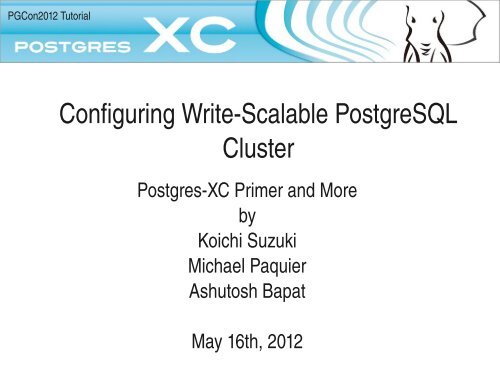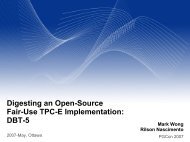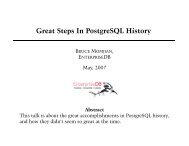Postgres-XC tutorial PDF - PGCon
Postgres-XC tutorial PDF - PGCon
Postgres-XC tutorial PDF - PGCon
You also want an ePaper? Increase the reach of your titles
YUMPU automatically turns print PDFs into web optimized ePapers that Google loves.
<strong>PGCon</strong>2012 Tutorial<br />
Configuring WriteScalable PostgreSQL<br />
Cluster<br />
<strong>Postgres</strong><strong>XC</strong> Primer and More<br />
by<br />
Koichi Suzuki<br />
Michael Paquier<br />
Ashutosh Bapat<br />
May 16th, 2012
Agenda<br />
●<br />
●<br />
●<br />
●<br />
●<br />
A – <strong>Postgres</strong><strong>XC</strong> introduction<br />
B Cluster design, navigation and configuration<br />
C Distributing data effectively<br />
D Backup and restore, high availability<br />
E <strong>Postgres</strong><strong>XC</strong> as a community<br />
May 16th, 2012 <strong>Postgres</strong><strong>XC</strong> 2
Chapter A<br />
<strong>Postgres</strong><strong>XC</strong> Introduction<br />
May 16th, 2012 <strong>Postgres</strong><strong>XC</strong> 3
A1<br />
What <strong>Postgres</strong><strong>XC</strong> is and<br />
what it is not<br />
May 16th, 2012 <strong>Postgres</strong><strong>XC</strong> 4
Summary (1)<br />
●<br />
PostgreSQLbased database cluster<br />
●<br />
Binary compatible applications<br />
– Many core extension<br />
●<br />
Catches up latest PostgreSQL version<br />
●<br />
– At present based upon PG 9.1. Soon will be upgraded to PG 9.2.<br />
Symmetric Cluster<br />
●<br />
No master, no slave<br />
– Not just PostgreSQL replication.<br />
– Application can read/write to any server<br />
●<br />
Consistent database view to all the transactions<br />
●<br />
– Complete ACID property to all the transactions in the cluster<br />
Scales both for Write and Read<br />
May 16th, 2012 <strong>Postgres</strong><strong>XC</strong> 5
Summary (2)<br />
●<br />
Not just a replication<br />
●<br />
●<br />
Configured to provide parallel transaction/statement handling.<br />
HA configuration needs separate setups (explained later)<br />
May 16th, 2012 <strong>Postgres</strong><strong>XC</strong> 6
Symmetric Cluster (1)<br />
PostgreSQL replication<br />
May 16th, 2012 <strong>Postgres</strong><strong>XC</strong> 7
Symmetric Cluster (2)<br />
<strong>Postgres</strong><strong>XC</strong> Cluster<br />
May 16th, 2012 <strong>Postgres</strong><strong>XC</strong> 8
Read/Write Scalability<br />
DBT1 throughput scalability<br />
May 16th, 2012 <strong>Postgres</strong><strong>XC</strong> 9
Present Status<br />
●<br />
●<br />
Project/Developer site<br />
●<br />
●<br />
http://postgres-xc.sourceforge.net/<br />
http://sourceforge.net/projects/postgres-xc/<br />
Now Version 1.0 available<br />
● Base PostgreSQL version: 9.1<br />
●<br />
– Promptly merged with PostgreSQL 9.2 when available<br />
64bit Linux on Intel X86_64 architecture<br />
– Tested on CentOS 5.8 and ubuntu 10.4<br />
May 16th, 2012 <strong>Postgres</strong><strong>XC</strong> 10
How to achieve R/W scalability<br />
Table distribution and replication<br />
●<br />
Each table can be distributed or replicated<br />
●<br />
●<br />
●<br />
●<br />
●<br />
Not a simple database replication<br />
Well suited to distribute star schema structure database<br />
– Transaction tables → Distributed<br />
– Master tables → Replicate<br />
Join pushdown<br />
Where clause pushdown<br />
Parallel aggregates<br />
May 16th, 2012 <strong>Postgres</strong><strong>XC</strong> 11
May 16th, 2012 <strong>Postgres</strong><strong>XC</strong> 12<br />
DBT1 Example<br />
C_ID<br />
C_UNAME<br />
C_PASSWD<br />
C_FNAME<br />
C_LNAME<br />
C_ADDR_ID<br />
C_PHONE<br />
C_EMAIL<br />
C_SINCE<br />
C_LAST_VISIT<br />
C_LOGIN<br />
C_EXPIRATION<br />
C_DISCOUNT<br />
C_BALANCE<br />
C_YTD_PMT<br />
C_BIRTHDATE<br />
C_DATA<br />
ADDR_ID<br />
ADDR_STREET1<br />
ADDR_STREET2<br />
ADDR_CITY<br />
ADDR_STATE<br />
ADDR_ZIP<br />
ADDR_CO_ID<br />
ADDR_C_ID<br />
O_ID<br />
O_C_ID<br />
O_DATE<br />
O_SUB_TOTAL<br />
O_TAX<br />
O_TOTAL<br />
O_SHIP_TYPE<br />
O_BILL_ADDR_ID<br />
O_SHIP_ADDR_ID<br />
O_STATUS<br />
CUSTOMER<br />
ADDRESS<br />
ORDERS<br />
OL_ID<br />
OL_O_ID<br />
OL_I_ID<br />
OL_QTY<br />
OL_DISCOUNT<br />
OL_COMMENTS<br />
OL_C_ID<br />
ORDER_LINE<br />
I_ID<br />
I_TITLE<br />
I_A_ID<br />
I_PUB_DATE<br />
I_PUBLISHER<br />
I_SUBJECT<br />
I_DESC<br />
I_RELATED1<br />
I_RELATED2<br />
I_RELATED3<br />
I_RELATED4<br />
I_RELATED5<br />
I_THUMBNAIL<br />
I_IMAGE<br />
I_SRP<br />
I_COST<br />
I_AVAIL<br />
I_ISBN<br />
I_PAGE<br />
I_BACKING<br />
I_DIMENASIONS<br />
ITEM<br />
CX_I_ID<br />
CX_TYPE<br />
CX_NUM<br />
CX_NAME<br />
CX_EXPIRY<br />
CX_AUTH_ID<br />
CX_XACT_AMT<br />
CX_XACT_DATE<br />
CX_CO_ID<br />
CX_C_ID<br />
CC_XACTS<br />
OL_ID<br />
OL_O_ID<br />
OL_I_ID<br />
OL_QTY<br />
OL_DISCOUNT<br />
OL_COMMENTS<br />
OL_C_ID<br />
AUTHOR<br />
ST_I_ID<br />
ST_STOCK<br />
STOCK<br />
SC_ID<br />
SC_C_ID<br />
SC_DATE<br />
SC_SUB_TOTAL<br />
SC_TAX<br />
SC_SHIPPING_COST<br />
SC_TOTAL<br />
SC_C_FNAME<br />
SC_C_LNAME<br />
SC_C>DISCOUNT<br />
SHOPPING_CART<br />
SCL_SC_ID<br />
SCL_I_ID<br />
SCL_QTY<br />
SCL_COST<br />
SCL_SRP<br />
SCL_TITLE<br />
SCL_BACKING<br />
SCL_C_ID<br />
SHOPPING_CART_LINE<br />
CO_ID<br />
CO_NAME<br />
CO_E<strong>XC</strong>HANGE<br />
CO_CURRENCY<br />
COUNTRY<br />
Distributed with<br />
Customer ID<br />
Replicated<br />
Distributed with<br />
ItemID<br />
Distributed with<br />
Shopping Cart ID
Major Difference from PostgreSQL<br />
●<br />
●<br />
●<br />
Table distribution/replication consideration<br />
●<br />
CREATE TABLE tab (…) DISTRIBUTE BY<br />
HASH(col) | MODULO(col) | REPLICATE<br />
Configuration<br />
●<br />
Purpose of this <strong>tutorial</strong><br />
Some missing features<br />
●<br />
●<br />
WHERE CURRENT OF<br />
Trigger<br />
● Savepoint ...<br />
May 16th, 2012 <strong>Postgres</strong><strong>XC</strong> 13
A2<br />
<strong>Postgres</strong><strong>XC</strong> Components<br />
May 16th, 2012 <strong>Postgres</strong><strong>XC</strong> 14
Summary<br />
●<br />
●<br />
Coordinator<br />
●<br />
●<br />
●<br />
Connection point from Apps<br />
SQL analysis and global planning<br />
Global SQL execution<br />
Datanode (or simply “NODE”)<br />
●<br />
Actual database store<br />
<strong>Postgres</strong><strong>XC</strong> Kernel, based upon<br />
vanilla PostgreSQL<br />
Share the binary<br />
Recommended to configure as<br />
a pair in OLTP Apps.<br />
●<br />
Local SQL execution<br />
●<br />
GTM (Global Transaction Manager)<br />
●<br />
Provides consistent database view to transactions<br />
– GXID (Global Transaction ID)<br />
– Snapshot (List of active transactions)<br />
Different binaries<br />
– Other global values such as SEQUENCE<br />
●<br />
GTM Proxy, integrates serverlocal transaction requirement for performance<br />
May 16th, 2012 <strong>Postgres</strong><strong>XC</strong> 15
How components work<br />
(HA components excluded)<br />
Apps<br />
Apps<br />
Apps<br />
Apps<br />
Connect to any one of<br />
the coordinators<br />
Coordinator<br />
Global<br />
Catalog<br />
Coordinator<br />
Global<br />
Catalog<br />
Datanode<br />
Local data<br />
Datanode<br />
Local data<br />
GTM Proxy<br />
GTM Proxy<br />
Server Machine<br />
(Or VM)<br />
Server Machine<br />
(Or VM)<br />
GTM<br />
May 16th, 2012 <strong>Postgres</strong><strong>XC</strong> 16
Difference from vanilla PostgreSQL<br />
●<br />
●<br />
●<br />
More than one <strong>Postgres</strong><strong>XC</strong> kernel (almost PostgreSQL<br />
kernel)<br />
GTM and GTMProxy<br />
May connect to any one of the coordinators<br />
●<br />
●<br />
Provide single database view<br />
Fullfledged transaction ACID property<br />
– Some restrictions in SSI (serializable)<br />
May 16th, 2012 <strong>Postgres</strong><strong>XC</strong> 17
How single database view is provided<br />
●<br />
Pick up vanilla PostgreSQL MVCC mechanism<br />
●<br />
●<br />
●<br />
Transaction ID (Transaction timestamp)<br />
Snapshot (list if active transactions)<br />
CLOG (whether given transaction is committed)<br />
● Made the former two global → GTM<br />
●<br />
●<br />
●<br />
CLOG is still locally maintained by coordinators and datanodes<br />
Every coordinator/datanode shares the same snapshot at any given time<br />
2PC is used for transactions spanning over multiple coordinators and/or<br />
datanodes<br />
●<br />
Has some performance penalty and may be improved in the future<br />
May 16th, 2012 <strong>Postgres</strong><strong>XC</strong> 18
How each component works<br />
Act as just PostgreSQL<br />
Determines which datanode(s) to go<br />
Distributed query planning<br />
Provide GXID and snapshot to datanode(s)<br />
Coordinator<br />
Global<br />
Catalog<br />
Handle local statement(s) from coordinators<br />
More like just single PostgreSQL<br />
Datanode<br />
Local data<br />
Reduce GTM interaction by grouping GTM request/response<br />
Takes care of connection/reconnection to GTM<br />
GTM Proxy<br />
Provides global transaction ID and snapshot<br />
Provides sequence<br />
GTM<br />
May 16th, 2012 <strong>Postgres</strong><strong>XC</strong> 19
Additional Info for configuration<br />
●<br />
●<br />
Both coordinator/datanode can have their own backups<br />
using PostgreSQL log shipping replication.<br />
GTM can be configured as “standby”, a live backup<br />
Explained later<br />
May 16th, 2012 <strong>Postgres</strong><strong>XC</strong> 20
Chapter B<br />
Cluster design, navigation and configuration<br />
Friendly approach to <strong>XC</strong><br />
May 16th, 2012 <strong>Postgres</strong><strong>XC</strong> 21
B1<br />
Design of cluster<br />
About servers and applications<br />
May 16th, 2012 <strong>Postgres</strong><strong>XC</strong> 22
General advice<br />
●<br />
Avoid data materialization on Coordinator<br />
postgres=# explain (costs false) select * from aa,bb where aa.a = bb.a;<br />
QUERY PLAN<br />
<br />
Data Node Scan on "__REMOTE_FQS_QUERY__"<br />
Node/s: dn1, dn2<br />
(2 rows)<br />
YES !<br />
NO !<br />
postgres=# explain (costs false) select * from aa,bb where aa.a = bb.a;<br />
QUERY PLAN<br />
<br />
Nested Loop<br />
Join Filter: (aa.a = bb.a)<br />
> Data Node Scan on aa<br />
Node/s: dn1, dn2<br />
> Data Node Scan on bb<br />
Node/s: dn1<br />
(6 rows)<br />
May 16th, 2012 <strong>Postgres</strong><strong>XC</strong> 23
Highavailability design<br />
●<br />
Streaming replication on critical<br />
nodes<br />
– Nodes having unique data<br />
Log shipping<br />
●<br />
– Do not care about unlogged tables<br />
for example<br />
GTMStandby<br />
Dn master<br />
Dn slave<br />
– GTM is SPOF<br />
Status backup<br />
– Need to fallback to a standby if<br />
failure GTM GTMStandby<br />
May 16th, 2012 <strong>Postgres</strong><strong>XC</strong> 24
Online transaction processing (OLTP)<br />
applications<br />
●<br />
Short readwrite transactions<br />
● Coordinator/Datanode CPU on same machine 30/70<br />
●<br />
1/3 ratio on separate servers/VMs<br />
Co1<br />
Clients<br />
●<br />
●<br />
Master table: replicated<br />
table used for joins<br />
Warehouse table of DBT2<br />
Dn1 Dn2 Dn3<br />
May 16th, 2012 <strong>Postgres</strong><strong>XC</strong> 25
Analytic applications<br />
●<br />
●<br />
Long readonly transactions<br />
1Co/1Dn on same server/VM<br />
Clients<br />
●<br />
Maximize local joins with<br />
preferred node<br />
…<br />
Co1/Dn1 Co2/Dn2 CoN/DnN<br />
May 16th, 2012 <strong>Postgres</strong><strong>XC</strong> 26
B2<br />
Code and binaries<br />
Code navigation and deployment<br />
May 16th, 2012 <strong>Postgres</strong><strong>XC</strong> 27
Structure of code 1<br />
●<br />
Code navigation:<br />
– Use of flags #ifdef PG<strong>XC</strong> .. #endif<br />
GTM<br />
– Folder: src/gtm/<br />
●<br />
– Contains GTM and GTMProxy code<br />
– <strong>Postgres</strong>side, GTMside and clients<br />
●<br />
Node location management<br />
– Folder: src/backend/pgxc/locator<br />
– Node hashing calculation and determination of executing node list<br />
May 16th, 2012 <strong>Postgres</strong><strong>XC</strong> 28
Structure of code 2<br />
●<br />
Pooler<br />
– Folder: src/backend/pgxc/pool/<br />
●<br />
– Pooler process, postgresside management<br />
Node manager<br />
– Folder: src/backend/pgxc/nodemgr/<br />
– Node and node group catalogs. Local node management<br />
●<br />
Planner<br />
– Folder: src/backend/pgxc/plan/<br />
●<br />
– Fastquery shipping code<br />
Documentation<br />
– Folder: docxc/<br />
May 16th, 2012 <strong>Postgres</strong><strong>XC</strong> 29
Compilation and deployment<br />
●<br />
Same as vanilla PostgreSQL<br />
– ./configure prefix...<br />
●<br />
– make html/man/world and make install<br />
Deployment methods:<br />
– Install core binaries/packages on all the servers/VMs involved<br />
●<br />
– Or... compile once and copy binaries to all the servers/VMs<br />
Configurator, automatic deployment through cluster<br />
– Written in Ruby<br />
– YAML configuration file<br />
– Not supported since 0.9.4 :(<br />
May 16th, 2012 <strong>Postgres</strong><strong>XC</strong> 30
B3<br />
Everything about configuration<br />
Settings and options<br />
May 16th, 2012 <strong>Postgres</strong><strong>XC</strong> 31
Initialization<br />
●<br />
●<br />
Initialization of GTM – creation of gtm.conf<br />
●<br />
●<br />
Mandatory options:<br />
– Data folder<br />
– GTM or GTMProxy?<br />
Example: initgtm Z gtm D $DATA_FOLDER<br />
Initialization of a node<br />
●<br />
●<br />
Mandatory option<br />
– Node name => nodename<br />
– Data folder => D<br />
Example: initdb nodename mynode D $DATA_FOLDER<br />
May 16th, 2012 <strong>Postgres</strong><strong>XC</strong> 32
Configuration parameters<br />
●<br />
●<br />
Basics are same as vanilla <strong>Postgres</strong><br />
Extra configuration for all the nodes<br />
– GTM connection parameters: gtm_host/gtm_port<br />
●<br />
– Node name: pgxc_node_name for self identification<br />
Coordinatoronly<br />
– Pooler parameters: pooler_port,min_pool_size, max_pool_size<br />
– persistent_datanode_connections, connections taken for session not<br />
sent back to pool<br />
May 16th, 2012 <strong>Postgres</strong><strong>XC</strong> 33
Parameters exclusive to <strong>XC</strong><br />
●<br />
enforce_two_phase_commit – default = on<br />
– Control of autocommit temporary objects<br />
●<br />
●<br />
– Turn to off to create temporary objects<br />
max_coordinators – default 16, max Coordinators usable<br />
max_datanodes – default 16, max Datanodes usable<br />
May 16th, 2012 <strong>Postgres</strong><strong>XC</strong> 34
Node startup<br />
●<br />
●<br />
Coordinator/Datanode<br />
●<br />
●<br />
●<br />
GTM<br />
●<br />
●<br />
Same options as vanilla <strong>Postgres</strong><br />
Except... Mandatory to choose if node starts up as a<br />
Coordinator (C) or a Datanode (X)<br />
Possible to set with pg_ctl Z coordinator/Datanode<br />
gtm D $DATA_FOLDER<br />
gtm_ctl start D $DATA_FOLDER S gtm<br />
May 16th, 2012 <strong>Postgres</strong><strong>XC</strong> 35
Commands – cluster management<br />
●<br />
●<br />
●<br />
CREATE/ALTER/DROP NODE<br />
CREATE NODE GROUP<br />
System functions<br />
●<br />
●<br />
pgxc_pool_check()<br />
pgxc_pool_reload()<br />
May 16th, 2012 <strong>Postgres</strong><strong>XC</strong> 36
Demonstration<br />
psql client<br />
GTM<br />
Port 6666<br />
Coordinator 1<br />
Port 5432<br />
Datanode 1<br />
Port 15432<br />
Datanode 2<br />
Port 15433<br />
May 16th, 2012 <strong>Postgres</strong><strong>XC</strong> 37
B4<br />
Data management and clusterrelated<br />
commands<br />
All the core mechanisms to manage and... check your cluster<br />
May 16th, 2012 <strong>Postgres</strong><strong>XC</strong> 38
CREATE TABLE extensions<br />
●<br />
Control of table distribution<br />
●<br />
DISTRIBUTE BY<br />
– REPLICATION<br />
– HASH(column)<br />
– ROUND ROBIN<br />
●<br />
Data repartition<br />
●<br />
●<br />
TO NODE node1, … nodeN<br />
TO GROUP nodegroup<br />
May 16th, 2012 <strong>Postgres</strong><strong>XC</strong> 39
<strong>Postgres</strong><strong>XC</strong> commands maintenance<br />
●<br />
●<br />
EXECUTE DIRECT<br />
●<br />
●<br />
●<br />
●<br />
Connect directly to a node<br />
SELECT queries only<br />
Can be used to check connection to a remote node<br />
Local maintenance<br />
CLEAN CONNECTION<br />
●<br />
Drop connections in pool for given database or user<br />
May 16th, 2012 <strong>Postgres</strong><strong>XC</strong> 40
Point in time recovery PITR<br />
●<br />
●<br />
CREATE BARRIER<br />
●<br />
●<br />
Addition of a barrier ID in Xlogs consistent in cluster<br />
Block 2PC transactions to have a consistent transaction status<br />
Recovery.conf – recovery_target_barrier<br />
●<br />
Specify a barrier ID in recovery.conf to recover a node up to a<br />
given barrier point<br />
May 16th, 2012 <strong>Postgres</strong><strong>XC</strong> 41
Cluster catalogs<br />
●<br />
●<br />
●<br />
pgxc_node – Information of remote nodes<br />
●<br />
●<br />
●<br />
Connection info: host/port<br />
Node type<br />
Node name<br />
pgxc_group – node group information<br />
pgxc_class – table distribution information<br />
●<br />
●<br />
●<br />
Table Oid<br />
Distribution type, distribution key<br />
Node list where table data is distributed<br />
May 16th, 2012 <strong>Postgres</strong><strong>XC</strong> 42
Chapter C<br />
Distributing data effectively<br />
Distribution strategies<br />
Choosing distribution strategy<br />
Transaction Management<br />
May 16th, 2012 <strong>Postgres</strong><strong>XC</strong> 43
Distributing the data<br />
●<br />
●<br />
Replicated table<br />
●<br />
●<br />
Each row in the table is replicated to the datanodes<br />
Statement based replication<br />
Distributed table<br />
●<br />
Each row of the table is stored on one datanode, decided by<br />
one of following strategies<br />
– Hash<br />
– Round Robin<br />
– Modulo<br />
– Range and user defined function – TBD<br />
May 16th, 2012 <strong>Postgres</strong><strong>XC</strong> 44
Replicated Tables<br />
Writes<br />
Reads<br />
write write write<br />
read<br />
val val2<br />
1 2<br />
2 10<br />
3 4<br />
val val2<br />
1 2<br />
2 10<br />
3 4<br />
val val2<br />
1 2<br />
2 10<br />
3 4<br />
val val2<br />
1 2<br />
2 10<br />
3 4<br />
val val2<br />
1 2<br />
2 10<br />
3 4<br />
val val2<br />
1 2<br />
2 10<br />
3 4<br />
May 16th, 2012 <strong>Postgres</strong><strong>XC</strong> 45
Replicated Tables<br />
●<br />
●<br />
●<br />
●<br />
Statement level replication<br />
Each write needs to be replicated<br />
●<br />
writes are costly<br />
Read can happen on any node (where table is replicated)<br />
●<br />
Reads are faster, since reads from different coordinators can<br />
be routed to different nodes<br />
Useful for relatively static tables, with high read load<br />
May 16th, 2012 <strong>Postgres</strong><strong>XC</strong> 46
Querying replicated tables<br />
●<br />
Example: simple SELECT on replicated table<br />
CREATE TABLE tab1 (val int, val2 int)<br />
DISTRIBUTE BY REPLICATION TO NODE datanode_1, datanode_2;<br />
EXPLAIN VERBOSE SELECT * FROM tab1 WHERE val2 = 5;<br />
QUERY PLAN<br />
<br />
Result<br />
Output: val, val2<br />
> Data Node Scan on tab1 Queries the datanode/s<br />
Output: val, val2<br />
Node/s: datanode_1 one node out of two is chosen<br />
Remote query: SELECT val, val2 FROM ONLY tab1 WHERE (val2 = 5)<br />
May 16th, 2012 <strong>Postgres</strong><strong>XC</strong> 47
Replicated tables multirow operations<br />
●<br />
Example: aggregation on replicated table<br />
EXPLAIN VERBOSE SELECT sum(val) FROM tab1 GROUP BY val2;<br />
QUERY PLAN<br />
<br />
HashAggregate Groups rows on coordinator, N(groups) < N(rows)<br />
Output: sum(val), val2<br />
> Data Node Scan on tab1<br />
Brings all the rows from one datanode to coordinator.<br />
Output: val, val2<br />
Node/s: datanode_1<br />
Remote query: SELECT val, val2 FROM ONLY tab1 WHERE true<br />
May 16th, 2012 <strong>Postgres</strong><strong>XC</strong> 48
Replicated tables – multirow operation<br />
Pushing aggregates to the datanodes for better performance<br />
EXPLAIN VERBOSE SELECT sum(val) FROM tab1 GROUP BY val2;<br />
QUERY PLAN<br />
<br />
Data Node Scan on "__REMOTE_FQS_QUERY__"<br />
Output: sum(tab1.val), tab1.val2<br />
Node/s: datanode_1<br />
Remote query: SELECT sum(val) AS sum FROM tab1 GROUP BY val2<br />
Get grouped and aggregated results from datanodes<br />
●<br />
Similarly push DISTINCT, ORDER BY etc.<br />
May 16th, 2012 <strong>Postgres</strong><strong>XC</strong> 49
Distributed Tables<br />
Write<br />
Read<br />
Combiner<br />
write<br />
read read read<br />
val<br />
val2<br />
val<br />
val2<br />
val<br />
val2<br />
val<br />
val2<br />
val<br />
val2<br />
val<br />
val2<br />
1 2<br />
2 10<br />
11 21<br />
21 101<br />
10 20<br />
20 100<br />
1 2<br />
2 10<br />
11 21<br />
21 101<br />
10 20<br />
20 100<br />
3 4<br />
31 41<br />
30 40<br />
3 4<br />
31 41<br />
30 40<br />
May 16th, 2012 <strong>Postgres</strong><strong>XC</strong> 50
Distributed Table<br />
●<br />
●<br />
●<br />
Write to a single row is applied only on the node where the<br />
row resides<br />
●<br />
Multiple rows can be written in parallel<br />
Scanning rows spanning across the nodes (e.g. table<br />
scans) can hamper performance<br />
Point reads and writes based on the distribution column<br />
value show good performance<br />
●<br />
Datanode where the operation happens can be identified by the<br />
distribution column value<br />
May 16th, 2012 <strong>Postgres</strong><strong>XC</strong> 51
Querying distributed table<br />
●<br />
Example: simple SELECT on distributed table<br />
CREATE TABLE tab1 (val int, val2 int)<br />
DISTRIBUTE BY HASH(val)<br />
TO NODE datanode_1, datanode_2, datanode_3; distributed table<br />
EXPLAIN VERBOSE SELECT * FROM tab1 WHERE val2 = 5;<br />
QUERY PLAN<br />
<br />
Data Node Scan on "__REMOTE_FQS_QUERY__"<br />
Gathers rows from the nodes where table is distributed<br />
Output: tab1.val, tab1.val2<br />
Node/s: datanode_1, datanode_2, datanode_3<br />
Remote query: SELECT val, val2 FROM tab1 WHERE (val2 = 5)<br />
May 16th, 2012 <strong>Postgres</strong><strong>XC</strong> 52
Distributed tables – multirow operations (1)<br />
●<br />
Example: aggregation on distributed table<br />
EXPLAIN VERBOSE SELECT sum(val) FROM tab1 GROUP BY val2;<br />
QUERY PLAN<br />
<br />
HashAggregate Groups rows on coordinator, N(groups) < N(rows)<br />
Output: sum(val), val2<br />
> Data Node Scan on tab1<br />
Brings all the rows from the datanode to coordinator.<br />
Output: val, val2<br />
Node/s: datanode_1, datanode_2, datanode_3<br />
Remote query: SELECT val, val2 FROM ONLY tab1 WHERE true<br />
May 16th, 2012 <strong>Postgres</strong><strong>XC</strong> 53
●<br />
Distributed tables – multirow operation (2)<br />
Example: aggregation on distributed table<br />
EXPLAIN VERBOSE SELECT sum(val) FROM tab1 GROUP BY val2;<br />
QUERY PLAN<br />
<br />
HashAggregate<br />
Output: pg_catalog.sum((sum(tab1.val))), tab1.val2<br />
Finalise the grouping and aggregation at coordinator<br />
> Data Node Scan on "__REMOTE_GROUP_QUERY__"<br />
Output: sum(tab1.val), tab1.val2<br />
Node/s: datanode_1, datanode_2, datanode_3<br />
Remote query: SELECT sum(group_1.val), group_1.val2<br />
FROM (SELECT val, val2 FROM ONLY tab1<br />
WHERE true) group_1 GROUP BY 2<br />
Get partially grouped and aggregated results from datanodes<br />
May 16th, 2012 <strong>Postgres</strong><strong>XC</strong> 54
●<br />
JOINs<br />
Example: Join on distribution key<br />
EXPLAIN VERBOSE SELECT * FROM tab1, tab2 WHERE tab1.val = tab2.val;<br />
QUERY PLAN<br />
<br />
Nested Loop – Perform JOIN on coordinator.<br />
Output: tab1.val, tab1.val2, tab2.val, tab2.val2<br />
Join Filter: (tab1.val = tab2.val)<br />
Queries to datanodes to fetch the rows from tab1 and tab2<br />
> Data Node Scan on tab1<br />
Output: tab1.val, tab1.val2<br />
Remote query: SELECT val, val2 FROM ONLY tab1 WHERE true<br />
> Data Node Scan on tab2<br />
Output: tab2.val, tab2.val2<br />
Remote query: SELECT val, val2 FROM ONLY tab2 WHERE true<br />
May 16th, 2012 <strong>Postgres</strong><strong>XC</strong> 55
JOINs<br />
●<br />
●<br />
Performing JOIN on coordinator won't be efficient if<br />
●<br />
●<br />
Number of rows selected
●<br />
Perfoming JOINs on datanodes<br />
Example: Join on distribution key<br />
EXPLAIN VERBOSE SELECT * FROM tab1, tab2 WHERE tab1.val = tab2.val;<br />
QUERY PLAN<br />
<br />
Data Node Scan on "__REMOTE_FQS_QUERY__"<br />
Output: tab1.val, tab1.val2, tab2.val, tab2.val2<br />
Node/s: datanode_1<br />
Remote query: SELECT tab1.val, tab1.val2, tab2.val, tab2.val2<br />
FROM tab1, tab2 WHERE (tab1.val = tab2.val)<br />
– JOIN performed on datanode<br />
May 16th, 2012 <strong>Postgres</strong><strong>XC</strong> 57
Performing JOINs on datanodes<br />
●<br />
●<br />
●<br />
Indexes can help to perform JOIN faster<br />
●<br />
Indexes available only on datanode<br />
Aggregates, grouping, sorting can as well be performed<br />
on datanode<br />
Always perform JOINs on the datanode<br />
●<br />
●<br />
In <strong>XC</strong>, coordinators do not have correct statistics, so can't<br />
predict the selectivity<br />
Proper costing model is yet to be implemented<br />
May 16th, 2012 <strong>Postgres</strong><strong>XC</strong> 58
Shippability of Joins<br />
Hash/Module distributed Round Robin Replicated<br />
Hash/Modulo distributed<br />
Inner join with equality<br />
condition on the<br />
distribution column with<br />
same data type and same<br />
distribution strategy<br />
NO<br />
Inner join if replicated<br />
table's distribution list is<br />
superset of distributed<br />
table's distribution list<br />
Round Robin No No Inner join if replicated<br />
table's distribution list is<br />
superset of distributed<br />
table's distribution list<br />
Replicated<br />
Inner join if replicated<br />
table's distribution list is<br />
superset of distributed<br />
table's distribution list<br />
Inner join if replicated<br />
table's distribution list is<br />
superset of distributed<br />
table's distribution list<br />
All kinds of joins<br />
May 16th, 2012 <strong>Postgres</strong><strong>XC</strong> 59
Constraints<br />
●<br />
●<br />
<strong>XC</strong> does not support Global constraints – i.e. constraints<br />
across datanodes<br />
Constraints within a datanode are supported<br />
Distribution strategy Unique, primary key constraints Foreign key constraints<br />
Replicated Supported Supported if the referenced table is<br />
also replicated on the same nodes<br />
Hash/Modulo distributed<br />
Supported if primary OR unique<br />
key is distribution key<br />
Supported if the referenced table is<br />
replicated on same nodes OR it's<br />
distributed by primary key in the<br />
same manner and same nodes<br />
Round Robin Not supported Supported if the referenced table is<br />
replicated on same nodes<br />
May 16th, 2012 <strong>Postgres</strong><strong>XC</strong> 60
Choosing distribution strategy (1)<br />
●<br />
Replication if<br />
●<br />
●<br />
●<br />
●<br />
●<br />
The table is lessfrequently written to<br />
The table's primary key is referenced by many distributed<br />
tables<br />
The table needs to have a primary key/unique key which is can<br />
not be distribution key<br />
The table is part of JOIN for many queries – makes easier to<br />
push the JOIN to the datanode<br />
Data redundancy<br />
May 16th, 2012 <strong>Postgres</strong><strong>XC</strong> 61
Choosing distribution strategy (2)<br />
●<br />
●<br />
Hash/Modulo distributed – if<br />
●<br />
●<br />
There are high pointread/write loads<br />
The queries have equality conditions on the distribution key,<br />
such that the data comes from only one node (essentially it<br />
becomes equivalent to replicated table for that query)<br />
Round Robin – if<br />
●<br />
There is no definite distribution key, but still want to balance the<br />
write load across the cluster<br />
May 16th, 2012 <strong>Postgres</strong><strong>XC</strong> 62
Example DBT1 (1)<br />
●<br />
author, item<br />
●<br />
●<br />
●<br />
●<br />
Less frequently written<br />
Frequently read from<br />
Author and item are frequently JOINed<br />
Hence replicated on all nodes<br />
May 16th, 2012 <strong>Postgres</strong><strong>XC</strong> 63
Example DBT1 (2)<br />
●<br />
customer, address, orders, order_line, cc_xacts<br />
●<br />
●<br />
●<br />
Frequently written<br />
– hence distributed<br />
Participate in JOINs amongst each other with customer_id as<br />
JOIN key, point SELECTs based on customer_id<br />
– hence diistributed by hash on customer_id so that JOINs are<br />
shippable<br />
Participate in JOINs with item<br />
– Having item replicated helps pushing JOINs to datanode<br />
May 16th, 2012 <strong>Postgres</strong><strong>XC</strong> 64
Example DBT1 (3)<br />
●<br />
Shopping_cart, shopping_cart_line<br />
●<br />
●<br />
●<br />
Frequently written<br />
– Hence distributed<br />
Point selects based on shopping_cart_id<br />
– Hence distributed by hash on shopping_cart_id<br />
JOINs with item on item_id<br />
– Having item replicated helps pushing JOINs to datanode<br />
May 16th, 2012 <strong>Postgres</strong><strong>XC</strong> 65
May 16th, 2012 <strong>Postgres</strong><strong>XC</strong> 66<br />
Example DBT1 (4)<br />
C_ID<br />
C_UNAME<br />
C_PASSWD<br />
C_FNAME<br />
C_LNAME<br />
C_ADDR_ID<br />
C_PHONE<br />
C_EMAIL<br />
C_SINCE<br />
C_LAST_VISIT<br />
C_LOGIN<br />
C_EXPIRATION<br />
C_DISCOUNT<br />
C_BALANCE<br />
C_YTD_PMT<br />
C_BIRTHDATE<br />
C_DATA<br />
ADDR_ID<br />
ADDR_STREET1<br />
ADDR_STREET2<br />
ADDR_CITY<br />
ADDR_STATE<br />
ADDR_ZIP<br />
ADDR_CO_ID<br />
ADDR_C_ID<br />
O_ID<br />
O_C_ID<br />
O_DATE<br />
O_SUB_TOTAL<br />
O_TAX<br />
O_TOTAL<br />
O_SHIP_TYPE<br />
O_BILL_ADDR_ID<br />
O_SHIP_ADDR_ID<br />
O_STATUS<br />
CUSTOMER<br />
ADDRESS<br />
ORDERS<br />
OL_ID<br />
OL_O_ID<br />
OL_I_ID<br />
OL_QTY<br />
OL_DISCOUNT<br />
OL_COMMENTS<br />
OL_C_ID<br />
ORDER_LINE<br />
I_ID<br />
I_TITLE<br />
I_A_ID<br />
I_PUB_DATE<br />
I_PUBLISHER<br />
I_SUBJECT<br />
I_DESC<br />
I_RELATED1<br />
I_RELATED2<br />
I_RELATED3<br />
I_RELATED4<br />
I_RELATED5<br />
I_THUMBNAIL<br />
I_IMAGE<br />
I_SRP<br />
I_COST<br />
I_AVAIL<br />
I_ISBN<br />
I_PAGE<br />
I_BACKING<br />
I_DIMENASIONS<br />
ITEM<br />
CX_I_ID<br />
CX_TYPE<br />
CX_NUM<br />
CX_NAME<br />
CX_EXPIRY<br />
CX_AUTH_ID<br />
CX_XACT_AMT<br />
CX_XACT_DATE<br />
CX_CO_ID<br />
CX_C_ID<br />
CC_XACTS<br />
OL_ID<br />
OL_O_ID<br />
OL_I_ID<br />
OL_QTY<br />
OL_DISCOUNT<br />
OL_COMMENTS<br />
OL_C_ID<br />
AUTHOR<br />
ST_I_ID<br />
ST_STOCK<br />
STOCK<br />
SC_ID<br />
SC_C_ID<br />
SC_DATE<br />
SC_SUB_TOTAL<br />
SC_TAX<br />
SC_SHIPPING_COST<br />
SC_TOTAL<br />
SC_C_FNAME<br />
SC_C_LNAME<br />
SC_C>DISCOUNT<br />
SHOPPING_CART<br />
SCL_SC_ID<br />
SCL_I_ID<br />
SCL_QTY<br />
SCL_COST<br />
SCL_SRP<br />
SCL_TITLE<br />
SCL_BACKING<br />
SCL_C_ID<br />
SHOPPING_CART_LINE<br />
CO_ID<br />
CO_NAME<br />
CO_E<strong>XC</strong>HANGE<br />
CO_CURRENCY<br />
COUNTRY<br />
Distributed with<br />
Customer ID<br />
Replicated<br />
Distributed with<br />
ItemID<br />
Distributed with<br />
Shopping Cart ID
DBT1 scaleup<br />
●<br />
Old data, we will publish benchmarks<br />
for 1.0 soon.<br />
●<br />
DBT1 (TPCW) benchmark with<br />
some minor modification to the<br />
schema<br />
●<br />
1 server = 1 coordinator + 1<br />
datanode on same machine<br />
●<br />
Coordinator is CPU bound<br />
●<br />
Datanode is I/O bound<br />
May 16th, 2012 <strong>Postgres</strong><strong>XC</strong> 67
Transaction management<br />
●<br />
●<br />
●<br />
●<br />
2PC is used to guarantee transactional consistency across nodes<br />
●<br />
●<br />
When there are more than one nodes involved OR<br />
When there are explicit 2PC transactions<br />
Only those nodes where write activity has happened, participate in<br />
2PC<br />
In PostgreSQL 2PC can not be applied if temporary tables are<br />
involved. Same restriction applies in <strong>Postgres</strong><strong>XC</strong><br />
When single coordinator command needs multiple datanode<br />
commands, we encase those in transaction block<br />
May 16th, 2012 <strong>Postgres</strong><strong>XC</strong> 68
Chapter D<br />
Backup, restore, recovery and high<br />
availability<br />
May 16th, 2012 <strong>Postgres</strong><strong>XC</strong> 69
Example configuration (1)<br />
●<br />
Coordinator x 2<br />
●<br />
Datanode x 2<br />
●<br />
coord1<br />
●<br />
datanode1<br />
– D=/home/koichi/pgxc/nodes/coord1<br />
– D=/home/koichi/pgxc/nodes/datanode1<br />
– port: 20004<br />
– port: 20006<br />
●<br />
coord2<br />
●<br />
datanode2<br />
– D=/home/koichi/pgxc/nodes/coord2<br />
– D=/home/koichi/pgxc/nodes/datanode2<br />
– port: 20005<br />
– port: 20007<br />
May 16th, 2012 <strong>Postgres</strong><strong>XC</strong> 70
Example configuration (2)<br />
●<br />
GTM<br />
●<br />
D /home/koichi/pgxc/nodes/gtm<br />
●<br />
port: 20001<br />
●<br />
GTM Proxy X 2<br />
●<br />
gtm_pxy1<br />
– D /home/koichi/pgxc/nodes/gtm_pxy1<br />
●<br />
GTMStandby<br />
●<br />
D /home/koichi/pgxc/nodes/gtm_standby<br />
●<br />
port: 20000<br />
●<br />
– port: 20002<br />
– Connects: coord1, datanode1<br />
gtm_pxy2<br />
– D /home/koichi/pgxc/nodes/gtm_pxy2<br />
– port: 20003<br />
– Connect: coord2, datanode2<br />
May 16th, 2012 <strong>Postgres</strong><strong>XC</strong> 71
D1<br />
Backup<br />
May 16th, 2012 <strong>Postgres</strong><strong>XC</strong> 72
General<br />
●<br />
Coordinator and Datanode<br />
●<br />
●<br />
●<br />
●<br />
No difference in principle from vanilla PostgreSQL<br />
pg_dump, pg_dumpall works globally<br />
Streaming replication should be configured for each coordinator and datanode<br />
Restoration should be consistent in all the nodes<br />
●<br />
●<br />
– Barrier<br />
GTM proxy<br />
●<br />
No dynamic data → Only static configuration files needs backup<br />
GTM<br />
●<br />
Need to backup current status → GTM Standby (explained later)<br />
May 16th, 2012 <strong>Postgres</strong><strong>XC</strong> 73
pg_dump, pg_dumpall, pg_restore<br />
●<br />
●<br />
●<br />
●<br />
You don't have to backup each node.<br />
Connect to one of the coordinators and issue pg_dump or<br />
pg_dumpall to backup.<br />
Connect to one of the coordinators and issue pg_restore<br />
to restore.<br />
pg_dump extended to support table distribution<br />
May 16th, 2012 <strong>Postgres</strong><strong>XC</strong> 74
Cold backup of each database cluster<br />
(static backup) (1)<br />
●<br />
●<br />
●<br />
After you stop all the components, you can backup all the<br />
physical files of each component.<br />
Restore them and simply restart all the components.<br />
To maintain whole cluster consistent, you must backup<br />
them all at the same occasion (after you stopped the<br />
whole cluster).<br />
May 16th, 2012 <strong>Postgres</strong><strong>XC</strong> 75
Cold backup of each database cluster<br />
(static backup) (2)<br />
●<br />
First, stop whole cluster<br />
$ pg_ctl stop -Z coordinator -D /home/kochi/pgxc/nodes/coord1 # -m fast<br />
$ pg_ctl stop -Z coordinator -D /home/koichi/pgxc/nodes/coord2 # -m fast<br />
$ pg_ctl stop -Z datanode -D /home/koichi/pgxc/nodes/datanode1 # -m fast<br />
$ pg_ctl stop -Z datanode -D /home/koichi/pgxc/nodes/datanode2 # -m fast<br />
$ gtm_ctl stop -S gtm_proxy -D /home/koichi/pgxc/nodes/gtm_pxy1<br />
$ gtm_ctl stop -S gtm_proxy -D /home/koichi/pgxc/nodes/gtm_pxy2<br />
$ gtm_ctl stop -S gtm -D /home/koichi/pgxc/nodes/gtm<br />
●<br />
●<br />
●<br />
You should run the above commands on each machines where each coordinator or<br />
datanode are running.<br />
You may not need m fast option if you disconnect all the connections from coordinator to<br />
datanode with CLEAN CONNECTION statement.<br />
As simple as vanilla PostgreSQL, but you should take care of all the running components.<br />
May 16th, 2012 <strong>Postgres</strong><strong>XC</strong> 76
Physical backup of each database cluster<br />
(static backup) (3)<br />
●<br />
Then, backup everything (tar is used in this case)<br />
$ cd /home/koichi/pgxc/node<br />
$ tar cvzf somewhere/gtm.tgz gtm<br />
$ tar cvzf somewhere/gtm_pxy1.tgz gtm_pxy1<br />
$ tar cvzf somewhere/gtm_pxy2.tgz gtm_pxy2<br />
$ tar cvzf somewhere/coord1.tgz coord1<br />
$ tar cvzf somewhere/coord2.tgz coord2<br />
$ tar cvzf somewhere/datanode1.tgz datanode1<br />
$ tar cvzf somewhere/datanode2.tgz datanode2<br />
●<br />
●<br />
●<br />
Again, as simple as vanilla PostgreSQL<br />
You can use your favorite backup tools. tar, rsync, whatsoever.<br />
Just you should take care of all the components.<br />
May 16th, 2012 <strong>Postgres</strong><strong>XC</strong> 77
Hot backup (1) General<br />
●<br />
●<br />
Similar to vanilla PostgreSQL<br />
You need to synchronize restoration point<br />
●<br />
Barrier: CREATE BARRIER 'barrier_id'<br />
– Advise to issue this command periodically from psql<br />
– Will propagate to all the component<br />
– Can be used as restoration point<br />
May 16th, 2012 <strong>Postgres</strong><strong>XC</strong> 78
Hot backup (2)<br />
●<br />
●<br />
●<br />
●<br />
Other are similar to vanilla PostgreSQL<br />
Again, you should take care of all the running nodes.<br />
Setup hot backup (base backup and WAL archiving) for<br />
each coordinator and datanode.<br />
GTM hot backup needs dedicated standby<br />
●<br />
Common to HA configuration<br />
May 16th, 2012 <strong>Postgres</strong><strong>XC</strong> 79
Coordinator/Datanode hot backup<br />
●<br />
Like standalone PG backup.<br />
For each coordinator/datanode, you should<br />
1. Configure WAL archiving<br />
2. Take base backups<br />
●<br />
Again, simple but have to take care of all.<br />
May 16th, 2012 <strong>Postgres</strong><strong>XC</strong> 80
Hot backup – coord1 example<br />
●<br />
Configure WAL archiving<br />
$ cat /home/koichi/pgxc/nodes/coord1/postgresql.conf<br />
●<br />
wal_level = archive<br />
archive_mode = on<br />
archive_command = 'cp -i %p /somewhere/%f
x option of pg_basebackup<br />
●<br />
●<br />
●<br />
This option includes WAL segments in the backup and enable to<br />
restore without WAL archiving.<br />
In <strong>XC</strong>, we should restore all the nodes to the same timestamp.<br />
You can use this option without WAL archiving<br />
●<br />
●<br />
If you are quite sure that x option includes your target “barrier” in<br />
backups of all the coordinator/datanode<br />
If you are not, you should configure WAL archiving to be sure that all<br />
the WAL files includes your target “barrier”.<br />
May 16th, 2012 <strong>Postgres</strong><strong>XC</strong> 82
GTM Hot Backup – GTM Sandby<br />
●<br />
●<br />
●<br />
●<br />
●<br />
●<br />
GTM has dedicated synchronous backup called GTMstandby.<br />
Just like PostgreSQL synchronous replication.<br />
GTM standby shares the binary with GTM.<br />
Start GTM, then GTMStandby. GTMStandby copies every<br />
request to GTM and maintains GTM's internal status as a backup.<br />
GTMStandby can be promoted to GTM with gtm_ctl command.<br />
GTMproxy can reconnect to promoted GTM.<br />
May 16th, 2012 <strong>Postgres</strong><strong>XC</strong> 83
Running GTMStandby<br />
●<br />
Run GTM as<br />
$ cat gtm_data_dir/gtm.conf<br />
nodename = 'gtm' # node name of your choice<br />
listen_addresses = 'gtm_ip_address'<br />
port = 20001<br />
# port number of your choice<br />
startup = ACT<br />
# specify ACT mode to start<br />
●<br />
$ gtm_ctl start -S gtm -D gtm_data_dir<br />
Run GTM standby as<br />
$ cat gtm_sby_data_dir/gtm.conf<br />
nodename = 'gtm_standby' # node name of your choice<br />
listen_addresses = 'gtm_standby_ip_address'<br />
port = 20000<br />
# port # of your choice<br />
startup = STANDBY # specfy to start as standby<br />
active_port = 20001 # ACT gtm port numer<br />
active_host = 'gtm_ip_address' # ACT gtm ip address<br />
$ gtm_ctl start -S gtm -D gtm_sby_data_dir<br />
May 16th, 2012 <strong>Postgres</strong><strong>XC</strong> 84
GTMStandby backs up<br />
●<br />
GTM standby backs up every status of GTM<br />
●<br />
To restore GTM with GTMStandby, you should promote GTMstandby (explained<br />
later)<br />
May 16th, 2012 <strong>Postgres</strong><strong>XC</strong> 85
D2<br />
Restore<br />
May 16th, 2012 <strong>Postgres</strong><strong>XC</strong> 86
Restore from pg_dump and pg_dumpall<br />
●<br />
●<br />
Initialize whole <strong>Postgres</strong><strong>XC</strong> cluster<br />
●<br />
Have been covered at “configuration”<br />
Run pg_restore<br />
●<br />
●<br />
●<br />
You don't have to run pg_restore for each coordinator/datanode<br />
Select one of the coordinator to connect and run pg_restore,<br />
that's all.<br />
Takes care of table distribution/replication<br />
May 16th, 2012 <strong>Postgres</strong><strong>XC</strong> 87
Restore from the cold backup (1)<br />
●<br />
Restore all the cold backups<br />
$ cd /home/koichi/pgxc/node<br />
$ tar xvzf somewhere/gtm.tgz<br />
$ tar xvzf somewhere/gtm_pxy1.tgz<br />
$ tar xvzf somewhere/gtm_pxy2.tgz<br />
$ tar xvzf somewhere/coord1.tgz<br />
$ tar xvzf somewhere/coord2.tgz<br />
$ tar xvzf somewhere/datanode1.tgz<br />
$ tar xvzf somewhre/datanode2.tgz<br />
May 16th, 2012 <strong>Postgres</strong><strong>XC</strong> 88
Restore from the cold backup (2)<br />
●<br />
Start all the components again<br />
$ gtm_ctl start -S gtm -D /home/koichi/pgxc/nodes/gtm<br />
$ gtm_ctl start -S gtm_proxy -D /home/koichi/pgxc/nodes/gtm_pxy1<br />
$ gtm_ctl start -S gtm_proxy -D /home/koichi/pgxc/nodes/gtm_pxy2<br />
$ pg_ctl start -Z datanode -D /home/koichi/pgxc/nodes/datanode1 -o “-i”<br />
$ pg_ctl start -Z datanode -D /home/koichi/pgxc/nodes/datanode2 -o “-i”<br />
$ pg_ctl start -Z coordinator -D /home/koichi/pgxc/nodes/coord1 -o “-i”<br />
$ pg_ctl start -Z coordinator -D /home/koichi/pgxc/nodes/coord2 -o “-i”<br />
●<br />
Restoration is done.<br />
May 16th, 2012 <strong>Postgres</strong><strong>XC</strong> 89
Restoration from the hot backup<br />
Coordinator and Datanode<br />
●<br />
●<br />
Restore the hot backup of each coordinator and datanode<br />
just like single PostgreSQL<br />
Make restore point consistent among coordinators and<br />
datanodes.<br />
●<br />
Specify Barrier ID as the restore point<br />
May 16th, 2012 <strong>Postgres</strong><strong>XC</strong> 90
Recovery.conf settings<br />
coord1 example<br />
$ cat /home/koichi/nodes/coord1/reconvery.conf<br />
restore_command = 'cp /somewhere/%f “%p”'<br />
recovery_target_barrier = 'barrier_id'<br />
$ pg_ctl start -Z coordinator -D /home/koichi/pgxc/nodes/coord1 -o “-i”<br />
●<br />
●<br />
●<br />
You can specify other recovery.conf options such as<br />
archive_cleanup_command if needed.<br />
Configure recover.conf file for every coordinator and datanode and<br />
start them with pg_ctl.<br />
Specify the same barrier_id value.<br />
May 16th, 2012 <strong>Postgres</strong><strong>XC</strong> 91
D3<br />
Recovery<br />
May 16th, 2012 <strong>Postgres</strong><strong>XC</strong> 92
When coordinator or datanode crashes<br />
●<br />
●<br />
●<br />
Any transaction involved in crashed coordinator or<br />
datanode will fail.<br />
If crash recovery runs, do it as vanilla PostgreSQL.<br />
If crash recovery does not run, you need archive recovery.<br />
●<br />
You should do archive recovery for every coordinator and<br />
datanode to maintain clusterwide data consistensy.<br />
May 16th, 2012 <strong>Postgres</strong><strong>XC</strong> 93
When GTMProxy crashes<br />
●<br />
●<br />
●<br />
GTMProxy does not have any dynamic data.<br />
Restore backup configuration file and restart.<br />
You may need to restart coordinator/datanode connected<br />
to the failed gtmproxy<br />
May 16th, 2012 <strong>Postgres</strong><strong>XC</strong> 94
If GTM crashes<br />
●<br />
●<br />
●<br />
●<br />
●<br />
●<br />
You must have run gtm_standby to recover from GTM<br />
crash.<br />
You must configure <strong>XC</strong> with gtm_proxy.<br />
Promote gtm_standby as gtm.<br />
Then reconnect gtm_proxy to the promoted gtm.<br />
You don't stop coordinators and/or datanodes.<br />
No transaction loss.<br />
May 16th, 2012 <strong>Postgres</strong><strong>XC</strong> 95
Running GTMStandby (again)<br />
●<br />
Run GTM as<br />
$ cat gtm_data_dir/gtm.conf<br />
nodename = 'gtm' # node name of your choice<br />
listen_addresses = 'gtm_ip_address'<br />
port = 20001<br />
# port number of your choice<br />
startup = ACT<br />
# specify ACT mode to start<br />
●<br />
$ gtm_ctl start -S gtm -D gtm_data_dir<br />
Run GTM standby as<br />
$ cat gtm_sby_data_dir/gtm.conf<br />
nodename = 'gtm_standby' # node name of your choice<br />
listen_addresses = 'gtm_standby_ip_address'<br />
port = 20000<br />
# port # of your choice<br />
startup = STANDBY # specfy to start as standby<br />
active_port = 20001 # ACT gtm port numer<br />
active_host = 'gtm_ip_address' # ACT gtm ip address<br />
$ gtm_ctl start -S gtm -D gtm_sby_data_dir<br />
May 16th, 2012 <strong>Postgres</strong><strong>XC</strong> 96
Run GTM Proxies<br />
$ cat /home/koichi/pgxc/nodes/gtm_pxy1/gtm_proxy.conf<br />
nodename = 'gtm_pxy1'<br />
listen_addresses = 'gtm_pxy1_ip_address'<br />
port = 20002<br />
gtm_host = 'gtm_ip_address'<br />
gtm_port = 20001<br />
$ gtm_ctl start -S gtm_proxy<br />
$ (do the same thing for gtm_pxy2 as well)<br />
May 16th, 2012 <strong>Postgres</strong><strong>XC</strong> 97
GTM recovery procedure<br />
$ (GTM crash found)<br />
$ gtm_ctl promote -S gtm \<br />
-D /home/koichi/nodes/gtm_standby<br />
$ gtm_ctl reconnect -S gtm_proxy \<br />
-D /home/koichi/pgxc/nodes/gtm_pxy1 \<br />
-o “-s gtm_standby_ip_addr -t 20000”<br />
$ gtm_ctl reconnect -S gtm_proxy \<br />
-D /home/koichi/pgxc/nodes/gtm_pxy2 \<br />
-o “-s gtm_standby_ip_addr -t 20000”<br />
May 16th, 2012 <strong>Postgres</strong><strong>XC</strong> 98
Additional gtm_proxy options<br />
●<br />
Timer to controls to deal with communication failure and wait for<br />
reconnect.<br />
err_wait_idle<br />
err_wait_count<br />
err_wait_interval<br />
# timer to wait for the first reconnect<br />
# (in second)<br />
# counts to wait for reconnect<br />
# timer to wait next reconnect (in second)<br />
gtm_connect_retry_idle<br />
# timer to retry connect to the current gtm when error is<br />
# detected (in second).<br />
gtm_connect_retry_count<br />
# number of connect retries<br />
gtm_connect_retry_interval<br />
# interval of connect retry to the current gtm when error is<br />
# detected (in second).<br />
May 16th, 2012 <strong>Postgres</strong><strong>XC</strong> 99
Running GTMStandby<br />
●<br />
Run GTM as<br />
$ cat gtm_data_dir/gtm.conf<br />
nodename = 'gtm' # node name of your choice<br />
listen_addresses = 'gtm_ip_address'<br />
port = 20001<br />
# port number of your choice<br />
startup = ACT<br />
# specify ACT mode to start<br />
●<br />
$ gtm_ctl start -S gtm -D gtm_data_dir<br />
Run GTM standby as<br />
$ cat gtm_sby_data_dir/gtm.conf<br />
nodename = 'gtm_standby' # node name of your choice<br />
listen_addresses = 'gtm_standby_ip_address'<br />
port = 20000<br />
# port # of your choice<br />
startup = STANDBY # specfy to start as standby<br />
active_port = 20001 # ACT gtm port numer<br />
active_host = 'gtm_ip_address' # ACT gtm ip address<br />
$ gtm_ctl start -S gtm -D gtm_sby_data_dir<br />
May 16th, 2012 <strong>Postgres</strong><strong>XC</strong> 100
Running GTMStandby<br />
●<br />
Run GTM as<br />
$ cat gtm_data_dir/gtm.conf<br />
nodename = 'gtm' # node name of your choice<br />
listen_addresses = 'gtm_ip_address'<br />
port = 20001<br />
# port number of your choice<br />
startup = ACT<br />
# specify ACT mode to start<br />
●<br />
$ gtm_ctl start -S gtm -D gtm_data_dir<br />
Run GTM standby as<br />
$ cat gtm_sby_data_dir/gtm.conf<br />
nodename = 'gtm_standby' # node name of your choice<br />
listen_addresses = 'gtm_standby_ip_address'<br />
port = 20000<br />
# port # of your choice<br />
startup = STANDBY # specfy to start as standby<br />
active_port = 20001 # ACT gtm port numer<br />
active_host = 'gtm_ip_address' # ACT gtm ip address<br />
$ gtm_ctl start -S gtm -D gtm_sby_data_dir<br />
May 16th, 2012 <strong>Postgres</strong><strong>XC</strong> 101
D4<br />
High Availability<br />
May 16th, 2012 <strong>Postgres</strong><strong>XC</strong> 102
HA General<br />
●<br />
●<br />
●<br />
●<br />
<strong>Postgres</strong><strong>XC</strong>'s HA feature should be achieved by<br />
integration with other HA middleware such as pacemaker<br />
(resource agent).<br />
GTM, GTMstandby and GTMproxies provides<br />
fundamental HA feature.<br />
Each coordinator and datanode should be configured with<br />
synchronous replication.<br />
This <strong>tutorial</strong> will focus on <strong>Postgres</strong><strong>XC</strong> configuration for HA<br />
middleware integration.<br />
May 16th, 2012 <strong>Postgres</strong><strong>XC</strong> 103
GTM configuration<br />
●<br />
●<br />
●<br />
GTM should be configured with GTMstandby and GTMproxy.<br />
Monitoring GTM, GTMstandby and GTMproxy can be<br />
done by process monitoring.<br />
Dedicated monitoring command can be implemented<br />
using direct interface to each of them.<br />
●<br />
●<br />
Need to be familiar with their internal structure.<br />
May be developed elsewhere.<br />
May 16th, 2012 <strong>Postgres</strong><strong>XC</strong> 104
Coordinator/datanode configuration<br />
●<br />
●<br />
●<br />
Again, same as vanilla PostgreSQL.<br />
Configure each coordinator and datanode synchronous replication<br />
as vanilla PostgreSQL.<br />
At failover, other coordinator/datanode must be notified new<br />
connection point.<br />
●<br />
●<br />
●<br />
●<br />
Use ALTER NODE command after the failover<br />
ALTER NODE datanode1 WITH<br />
(HOST = 'new_ip_addr', PORT = 20010);<br />
Then, SELECT pgxc_pool_reload()<br />
Need to run pgxc_clean to cleanup 2PC status.<br />
Other procedure is the same as vanilla PostgreSQL standby server settings and<br />
operation.<br />
May 16th, 2012 <strong>Postgres</strong><strong>XC</strong> 105
Why pgxc_clean?<br />
●<br />
When a node is failed over or recovered, 2PC status could<br />
be inconsistent.<br />
●<br />
●<br />
At some nodes, transaction has been committed or aborted but<br />
at other nodes, it might remain prepared.<br />
pgxc_clean collects such outstanding 2PC transaction status<br />
and correct them.<br />
May 16th, 2012 <strong>Postgres</strong><strong>XC</strong> 106
Cleaningup outstanding 2PC<br />
●<br />
●<br />
●<br />
●<br />
●<br />
Collects all the prepared transactions at all the coordinator and<br />
datanode.<br />
Check if prepared transactions are committed or aborted at other<br />
nodes.<br />
If committed/aborted, then commits/aborts the transaction at<br />
prepared nodes.<br />
If implicit 2PC transaction is only prepared, it is intended to be<br />
committed and commit it.<br />
If outstanding 2PC transaction is committed and aborted in other<br />
nodes, it is an error. pgxc_clean will notify to operator and let<br />
operator solve it manually.<br />
May 16th, 2012 <strong>Postgres</strong><strong>XC</strong> 107
Chapter E<br />
<strong>Postgres</strong><strong>XC</strong> as a community<br />
How to enter the sect...<br />
May 16th, 2012 <strong>Postgres</strong><strong>XC</strong> 108
Sites to know<br />
●<br />
●<br />
●<br />
Main management in Source Forge<br />
●<br />
●<br />
URL: http://sourceforge.net/projects/postgresxc/<br />
Bug tracker, mailing lists...<br />
Other GIT repository in Github<br />
●<br />
●<br />
URL: https://github.com/postgresxc/postgresxc<br />
Mirror of official repository in Source Forge<br />
Project webpage<br />
●<br />
●<br />
URL: http://postgresxc.sourceforge.net/<br />
Roadmap, mailing list details, members, docs<br />
May 16th, 2012 <strong>Postgres</strong><strong>XC</strong> 109
Mailing lists<br />
●<br />
●<br />
●<br />
●<br />
All the details in project webpage<br />
●<br />
●<br />
●<br />
http://postgresxc.sourceforge.net/<br />
Section Mailing list, with subscription links<br />
postgresxcXXX@lists.sourceforge.net<br />
General: postgresxcgeneral<br />
Hackers: postgresxcdevelopers<br />
GIT commits: postgresxccommitters<br />
May 16th, 2012 <strong>Postgres</strong><strong>XC</strong> 110
Documentation<br />
●<br />
●<br />
Published in http://postgresxc.sourceforge.net<br />
●<br />
Section Documentation<br />
Concerned release and branches<br />
●<br />
master (automatically daily uploaded)<br />
● Stable releases from 1.0<br />
May 16th, 2012 <strong>Postgres</strong><strong>XC</strong> 111
Daily snapshots and build farming<br />
●<br />
●<br />
Published in http://postgresxc.sourceforge.net<br />
Tarball daily snapshots<br />
– Based on latest commit of master branch<br />
– Contains html and man pages<br />
●<br />
Regression and performance results<br />
– Regressions<br />
●<br />
●<br />
Tests based on PostgreSQL + <strong>XC</strong> related tests<br />
Daily automatic tests<br />
– Performance<br />
●<br />
Daily automatic tests based on DBT1<br />
● On master and stable branches from 1.0<br />
May 16th, 2012 <strong>Postgres</strong><strong>XC</strong> 112
Release policy and code merge<br />
May 16th, 2012 <strong>Postgres</strong><strong>XC</strong> 113
How to contribute<br />
●<br />
●<br />
●<br />
●<br />
●<br />
As a tester bug report<br />
As a packager<br />
●<br />
Debian, RPM, pkg...<br />
As a coder<br />
●<br />
●<br />
Why not writing new stuff? => Feature requests in SF tracker<br />
Bug correction and stabilization? => Bug tracker in SF<br />
As a documentation correcter<br />
Anything I am forgetting here...<br />
May 16th, 2012 <strong>Postgres</strong><strong>XC</strong> 114
What next?<br />
● First major release, based on <strong>Postgres</strong> 9.1 => 1.0<br />
●<br />
Next move<br />
● Merge with <strong>Postgres</strong> 9.2<br />
●<br />
●<br />
●<br />
●<br />
Data redistribution<br />
Node addition and deletion<br />
Triggers<br />
Global constraints<br />
● 1.1 at the end of October 2012 (?)<br />
May 16th, 2012 <strong>Postgres</strong><strong>XC</strong> 115
Contact information<br />
●<br />
●<br />
●<br />
Koichi Suzuki<br />
●<br />
koichi.clarinet@gmail.com<br />
Ashutosh Bapat<br />
●<br />
ashutosh.bapat@enterprisedb.com<br />
Michael Paquier<br />
●<br />
●<br />
michael.paquier@gmail.com<br />
Twitter: @michaelpq<br />
May 16th, 2012 <strong>Postgres</strong><strong>XC</strong> 116
Thank You Very Much!<br />
May 16th, 2012 <strong>Postgres</strong><strong>XC</strong> 117
















